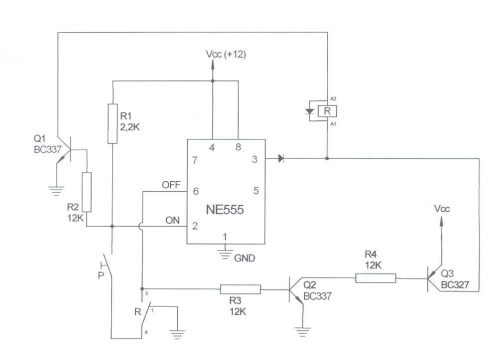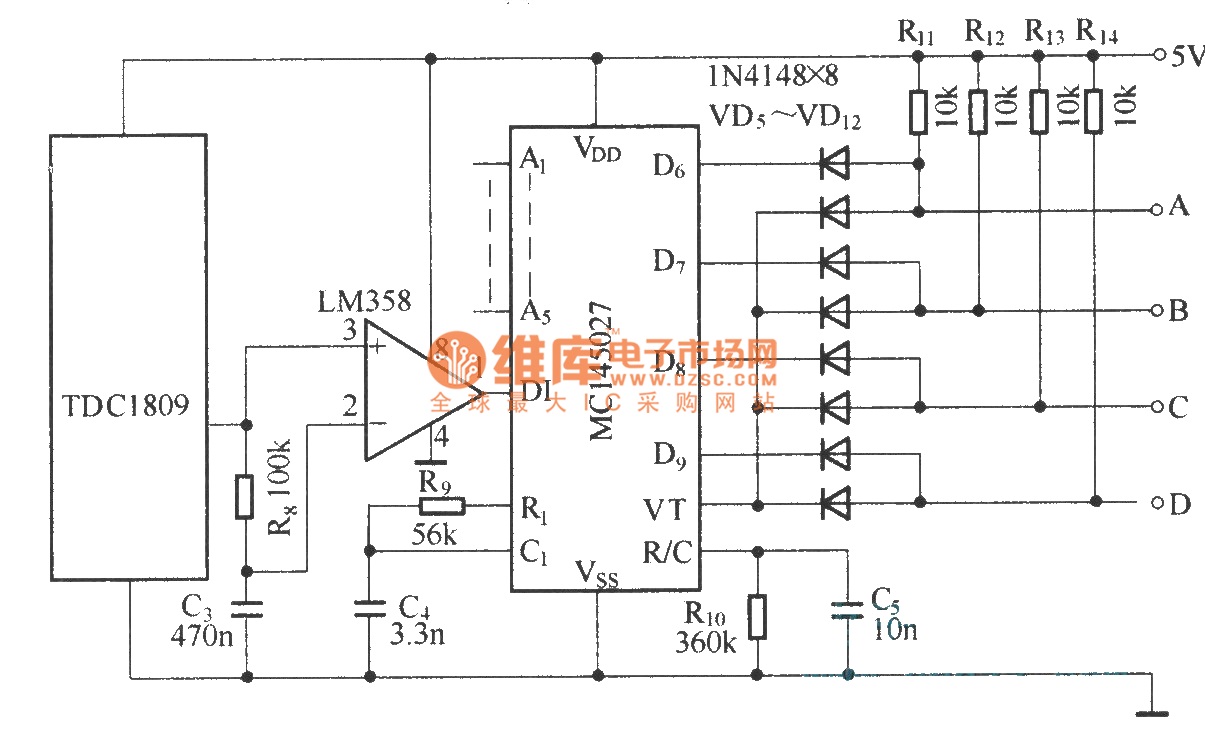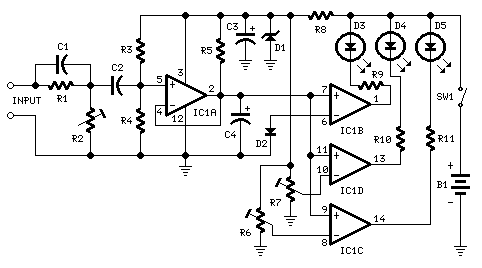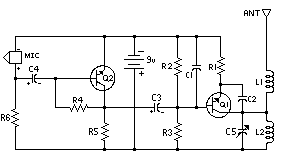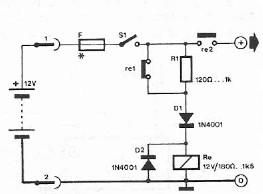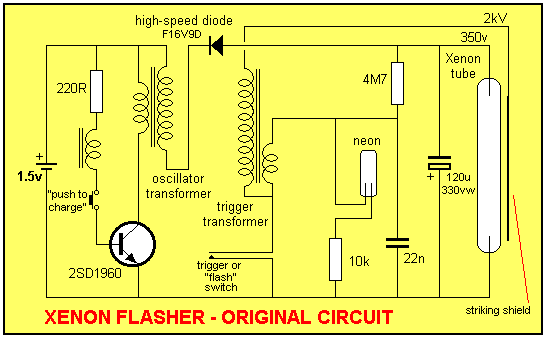
Acoustic Field Generator Circuit
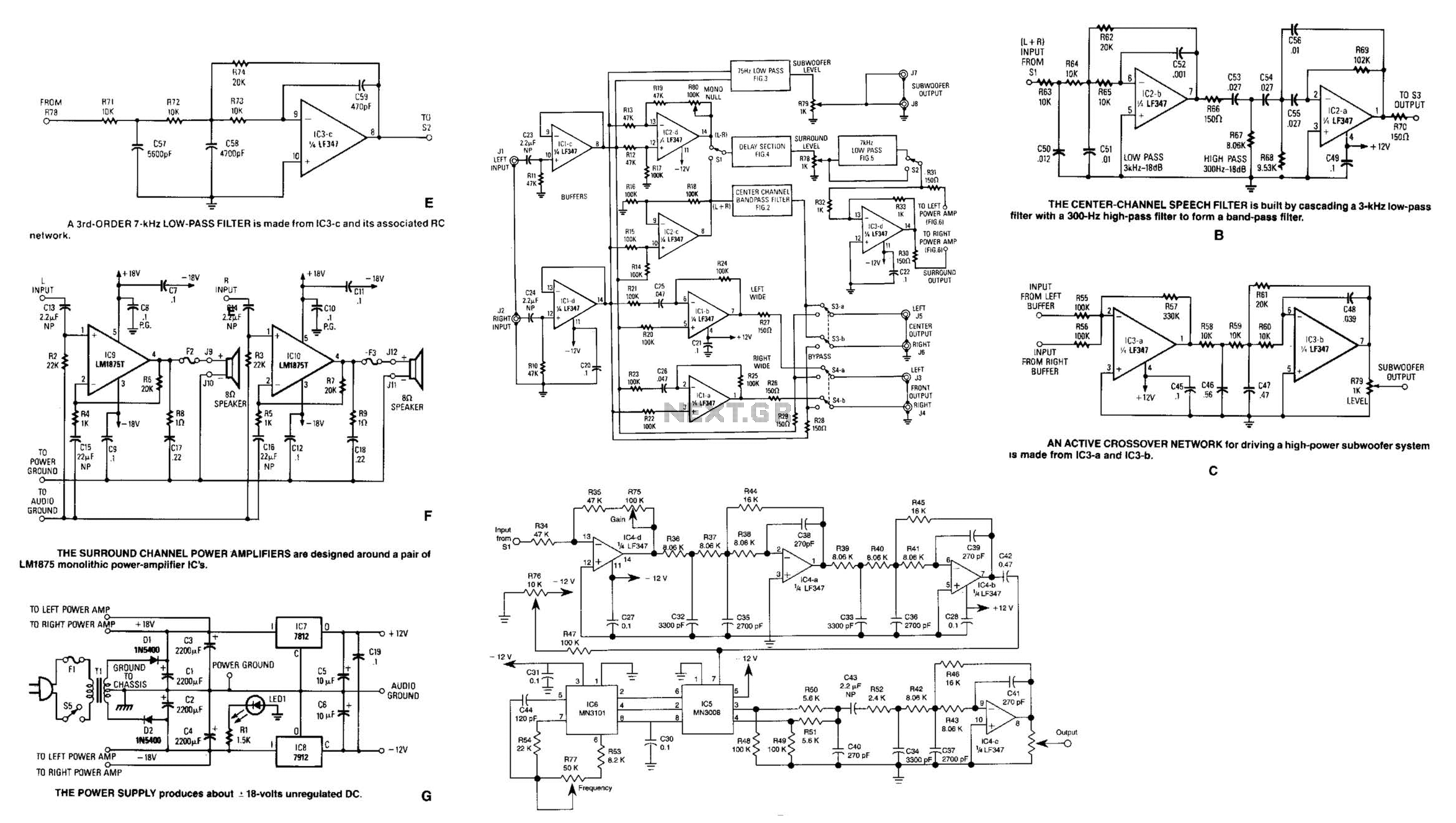
Referring to the simplified schematic in A, the audio frequency generator (AFG) consists of 10 relatively simple circuit elements. IC1-c and IC1-d are configured as unity-gain non-inverting buffer amplifiers. The summing amplifier, IC2-c, combines equal amounts of the left and right signals through resistors R14 and R15 to produce a total composite signal. Left- and right-channel signals are applied equally through resistors R13 and R12 to IC2-d, the difference (L-R) decoder. Any common signal to both channels is canceled by IC2-d, which precisely balances the inverting and non-inverting gains of the amplifier for a perfect null. The stereo width-enhancement circuit, composed of IC1-a and IC1-b, operates similarly to the (L-R) decoder, with capacitors C25 and C26 added to the inverting inputs of each operational amplifier. IC1-b generates the left wide signal, as its inverting and non-inverting inputs are connected to the left and right channels in opposition to IC1-a. The output of the width-enhancement circuit is routed to switch S4, which selects either the wide or the bypass signal for feeding the front-channel amplifier.
The center-channel dialogue filter is constructed by cascading a 3-kHz low-pass filter with a 3-Hz high-pass filter to create a band-pass filter. This filter exhibits a sharp -18 dB/octave cutoff, a flat voltage and power frequency response, and minimal phase change within the passband. In section C, IC3-a and IC3-b form an active crossover network for driving a subwoofer. IC3-a sums signals from the left- and right-channel buffer amplifiers, inverts the summed signal 180 degrees, and provides a low driving impedance for the subsequent filter stage. IC3-b, along with its associated RC network, forms a 75-Hz, 3rd-order low-pass filter. This filter inverts the signal another 180 degrees, ensuring that the signal across resistor R79 (which acts as the output-level control) is back in phase with the original input signal.
The delay section of the AFG, illustrated in D, is based on the MN3008 bucket brigade device (BBD) and the MN3101 two-phase variable-frequency clock generator. The required delay in this system ranges from approximately 5 to 35 milliseconds. The delay time of a BBD is determined by the number of stages divided by twice the clock frequency. Resistors R53, R54, R77, and capacitor C44 are selected to produce a clock frequency, adjustable via R77, which varies from about 30 kHz to 130 kHz. In section A, switch S1 selects the signal to be delayed: either the difference signal (L-R) from IC2-d in matrix mode or the sum signal (L+R) from IC2-c in concert mode. The chosen signal is routed from S1 to the delay section (D), where IC4-d is configured as an inverting amplifier; resistor R75 adjusts the gain between unity and X3. Integrated circuits IC4-a and IC4-b, along with their associated RC networks, are identical 3rd-order 15 kHz low-pass filters. The cascading of these two filters results in a very sharp cutoff (-36 dB per octave). Potentiometer R76 adjusts the bias voltage required by the BBD to precisely one half of the supply voltage, as specified.
The power supply for the AFG, depicted in section G, follows a conventional design. A 25-V center-tapped transformer, along with diodes D1 and D2, provides approximately 18-V unregulated DC. Two 2200 μF filter capacitors ensure sufficient energy storage to meet the high-current demands of the audio output amplifier integrated circuits during high output peaks. Referring to the simplified schematic in A, the AFG is made up of 10 relatively simple circuit elements. ICl-c and ICl-d arc configured as unity-gain noninverting buffer amplifiers. The summing (L+R) amplifier, IC2-c, combines equal amounts of the left and right signals, via R14 and R15, to develop a total composite signal.
Left- and right-channel signals are applied equally through R13 and R12 to IC2-d, the difference (L-R) decoder. Any common to both channels is canceled by IC2-d, which exactly balances the inverting and noninverting gains of the amplifier for a perfect null, The stereo width-enhancement circuit made up from ICl-a and IC`-b works similarly to the (L-R) decoder, except that C25 and C26 have been added in the inverting inputs of each op amp.
ICl-b develops the left wide signal because its inverting and noninverting inputs are connected to the left and right channels opposite that of ICl-a, The output of the width-enhancement circuit is routed to S4, which selects either the wide or the bypass signal for feeding the front-channel amplifier. The center-channel dialogue filter is built by cascading a 3-kHz low-pass filter with a 3-Hz liigh-pass filter to form a band-pass filter. It has a sharp -18 dB/octave cutoff, a flat voltage and power frequency response, and minimum phase change within the passband.
In C, IC3-a and IC3-b form an active crossover network for driving a subwoofer. IC3-a sums signals from the left- and right-channel buffer amps, it inverts the summed signal 180 degrees, and provides a low driving impedance for the following filter stage. IC3-b and its associated RC network form a 75-Hz, 3rd-order low-pass filter. The filter inverts the signal another 180 degrees, so the signal that appears across R79 (which is the output-level control) is back in phase with the original input signal.
The delay section of the AFG, shown in D, is built around the MN3008 bucket brigade device (BBD), arid the MN3101 two- phase variable-frequcncy clock generator. The amount of delay required in this system varies between approximately 5 to 35 milliseconds. The delay time of a BBD is equal to the number of stages divided by twice the clock frequency. Values were chosen for R53, R54, R77, and C44, to produce a clock frequency, adjustable via R77, which varies from about 30 kHz to 130 kHz.
In A, SI selects the signal to be delayed; either the difference signal (L-R) from IC2-d in the matrix mode or the sum signal (L+i) from IC2-c in the concert mode. The selected signal is fed from SI to the delay section (D) where IC4-d is configured as an inverting amplifier; R75 adjusts the gain between unity and X3.
Integrated circuits IC4-a and IC4-b, along with their assoicated RC networks, are identical 3rd-order 15:kHz low-pass filters. Cascading two filters produces a very sharp cut off (-36 dB per octave). Potentiometer R76 adjusts the bias voltage required by the BBD to exactly one half the supply voltage, as required.
The power supply of the AFG, shown in G, is of conventional design. A 25-V center-tapped transformer, along with diodes D1 and D2, produces about 18-V unregulated dc. Two 2200- filter capacitors provide ample energy storage to meet the high-current demands of the audio output amplifier ICs during high output peaks.
The center-channel dialogue filter is constructed by cascading a 3-kHz low-pass filter with a 3-Hz high-pass filter to create a band-pass filter. This filter exhibits a sharp -18 dB/octave cutoff, a flat voltage and power frequency response, and minimal phase change within the passband. In section C, IC3-a and IC3-b form an active crossover network for driving a subwoofer. IC3-a sums signals from the left- and right-channel buffer amplifiers, inverts the summed signal 180 degrees, and provides a low driving impedance for the subsequent filter stage. IC3-b, along with its associated RC network, forms a 75-Hz, 3rd-order low-pass filter. This filter inverts the signal another 180 degrees, ensuring that the signal across resistor R79 (which acts as the output-level control) is back in phase with the original input signal.
The delay section of the AFG, illustrated in D, is based on the MN3008 bucket brigade device (BBD) and the MN3101 two-phase variable-frequency clock generator. The required delay in this system ranges from approximately 5 to 35 milliseconds. The delay time of a BBD is determined by the number of stages divided by twice the clock frequency. Resistors R53, R54, R77, and capacitor C44 are selected to produce a clock frequency, adjustable via R77, which varies from about 30 kHz to 130 kHz. In section A, switch S1 selects the signal to be delayed: either the difference signal (L-R) from IC2-d in matrix mode or the sum signal (L+R) from IC2-c in concert mode. The chosen signal is routed from S1 to the delay section (D), where IC4-d is configured as an inverting amplifier; resistor R75 adjusts the gain between unity and X3. Integrated circuits IC4-a and IC4-b, along with their associated RC networks, are identical 3rd-order 15 kHz low-pass filters. The cascading of these two filters results in a very sharp cutoff (-36 dB per octave). Potentiometer R76 adjusts the bias voltage required by the BBD to precisely one half of the supply voltage, as specified.
The power supply for the AFG, depicted in section G, follows a conventional design. A 25-V center-tapped transformer, along with diodes D1 and D2, provides approximately 18-V unregulated DC. Two 2200 μF filter capacitors ensure sufficient energy storage to meet the high-current demands of the audio output amplifier integrated circuits during high output peaks. Referring to the simplified schematic in A, the AFG is made up of 10 relatively simple circuit elements. ICl-c and ICl-d arc configured as unity-gain noninverting buffer amplifiers. The summing (L+R) amplifier, IC2-c, combines equal amounts of the left and right signals, via R14 and R15, to develop a total composite signal.
Left- and right-channel signals are applied equally through R13 and R12 to IC2-d, the difference (L-R) decoder. Any common to both channels is canceled by IC2-d, which exactly balances the inverting and noninverting gains of the amplifier for a perfect null, The stereo width-enhancement circuit made up from ICl-a and IC`-b works similarly to the (L-R) decoder, except that C25 and C26 have been added in the inverting inputs of each op amp.
ICl-b develops the left wide signal because its inverting and noninverting inputs are connected to the left and right channels opposite that of ICl-a, The output of the width-enhancement circuit is routed to S4, which selects either the wide or the bypass signal for feeding the front-channel amplifier. The center-channel dialogue filter is built by cascading a 3-kHz low-pass filter with a 3-Hz liigh-pass filter to form a band-pass filter. It has a sharp -18 dB/octave cutoff, a flat voltage and power frequency response, and minimum phase change within the passband.
In C, IC3-a and IC3-b form an active crossover network for driving a subwoofer. IC3-a sums signals from the left- and right-channel buffer amps, it inverts the summed signal 180 degrees, and provides a low driving impedance for the following filter stage. IC3-b and its associated RC network form a 75-Hz, 3rd-order low-pass filter. The filter inverts the signal another 180 degrees, so the signal that appears across R79 (which is the output-level control) is back in phase with the original input signal.
The delay section of the AFG, shown in D, is built around the MN3008 bucket brigade device (BBD), arid the MN3101 two- phase variable-frequcncy clock generator. The amount of delay required in this system varies between approximately 5 to 35 milliseconds. The delay time of a BBD is equal to the number of stages divided by twice the clock frequency. Values were chosen for R53, R54, R77, and C44, to produce a clock frequency, adjustable via R77, which varies from about 30 kHz to 130 kHz.
In A, SI selects the signal to be delayed; either the difference signal (L-R) from IC2-d in the matrix mode or the sum signal (L+i) from IC2-c in the concert mode. The selected signal is fed from SI to the delay section (D) where IC4-d is configured as an inverting amplifier; R75 adjusts the gain between unity and X3.
Integrated circuits IC4-a and IC4-b, along with their assoicated RC networks, are identical 3rd-order 15:kHz low-pass filters. Cascading two filters produces a very sharp cut off (-36 dB per octave). Potentiometer R76 adjusts the bias voltage required by the BBD to exactly one half the supply voltage, as required.
The power supply of the AFG, shown in G, is of conventional design. A 25-V center-tapped transformer, along with diodes D1 and D2, produces about 18-V unregulated dc. Two 2200- filter capacitors provide ample energy storage to meet the high-current demands of the audio output amplifier ICs during high output peaks.
